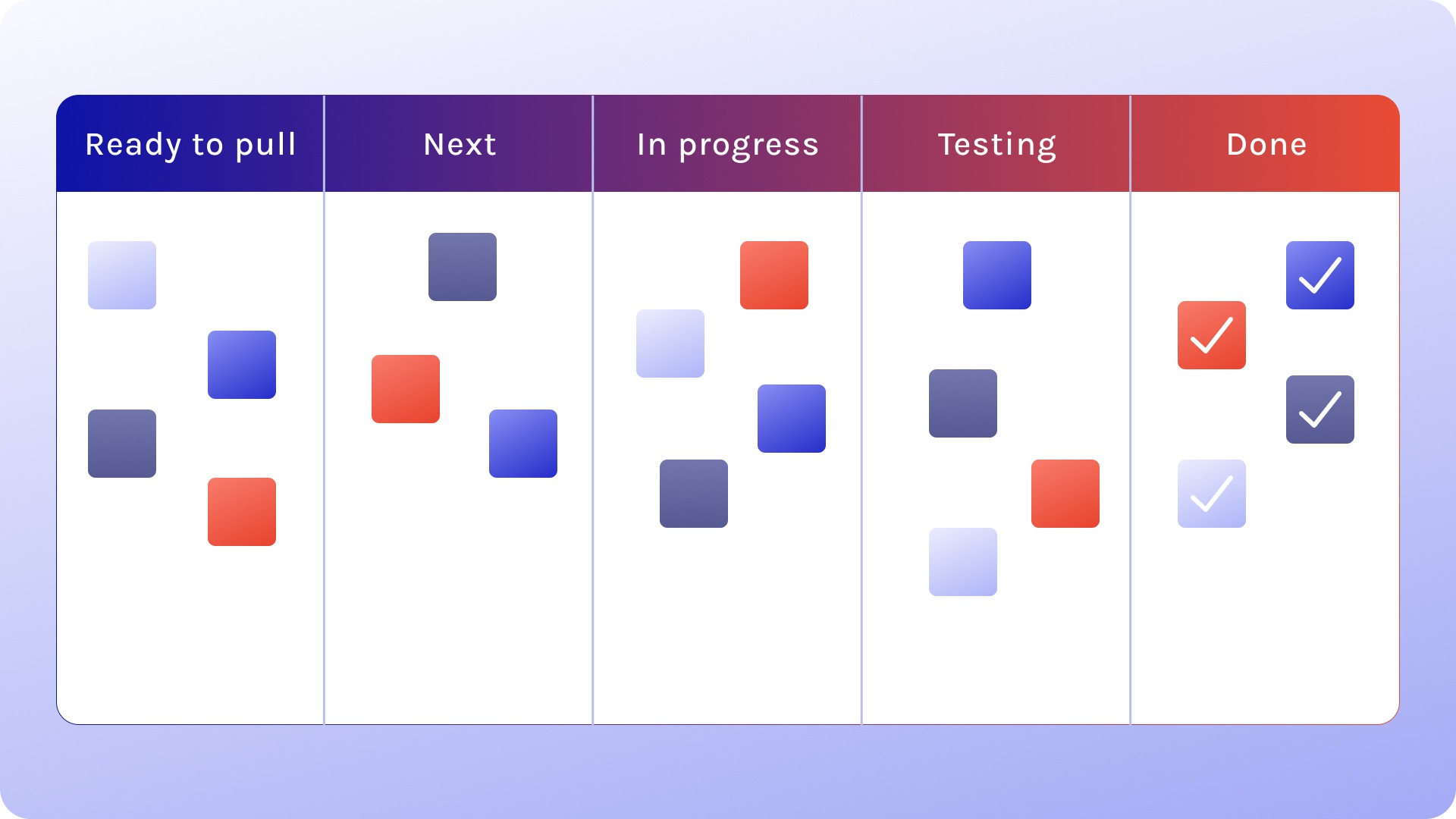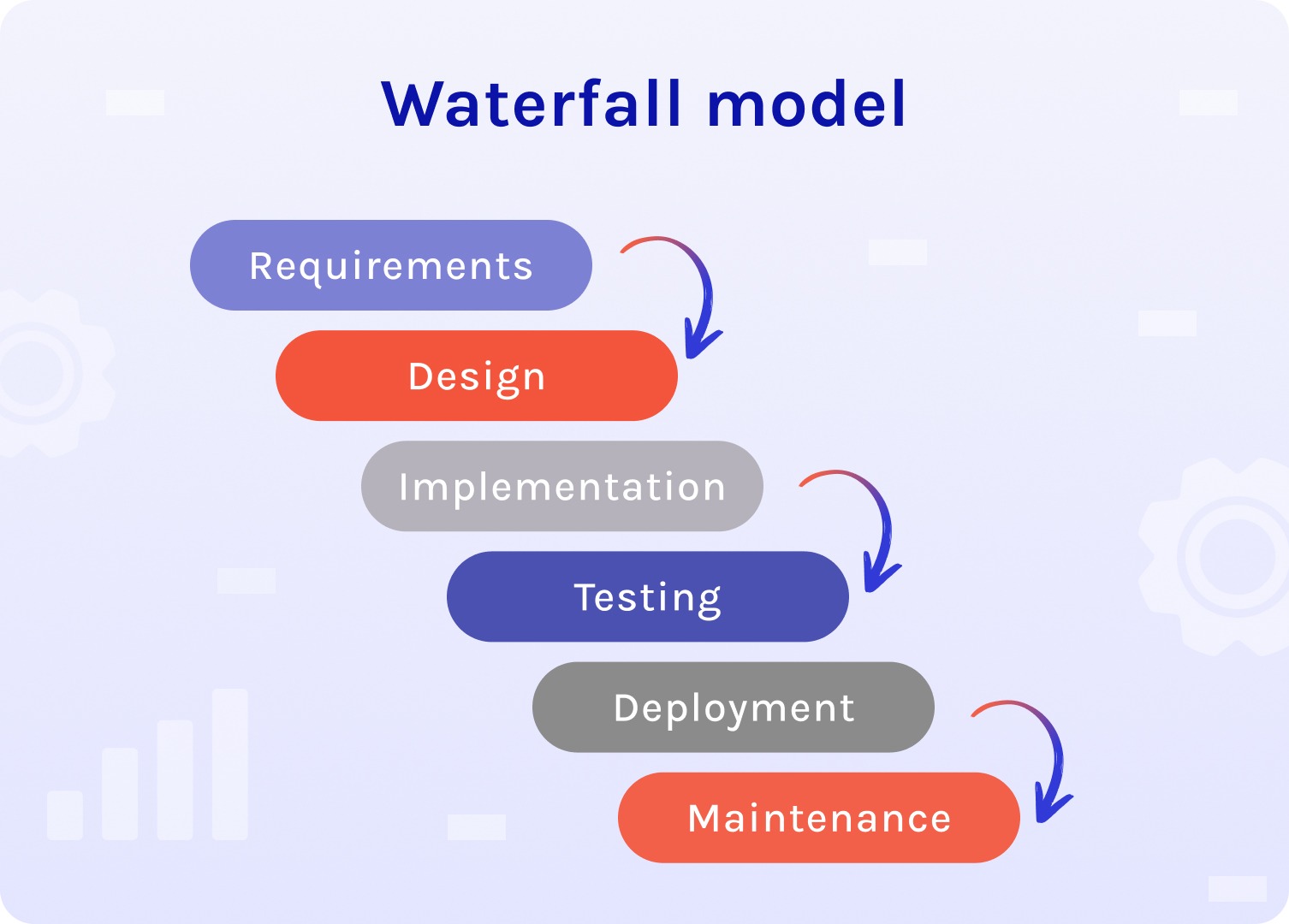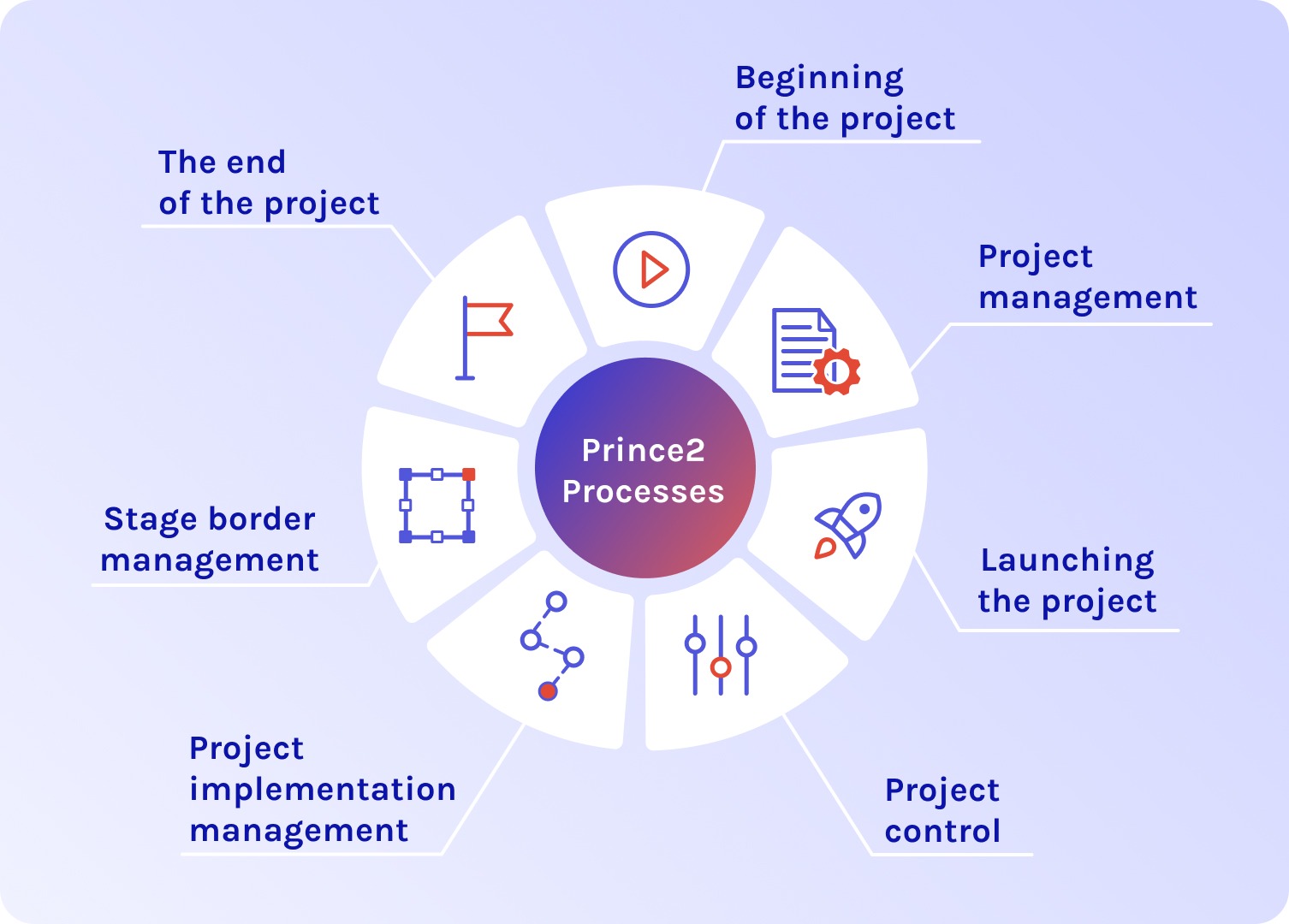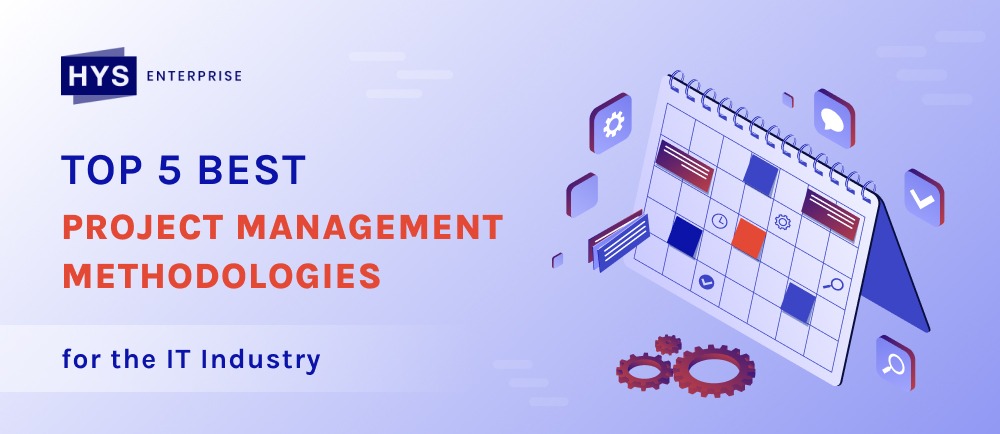There isn’t a one-size-fits-all answer regarding the best project management methodology for IT. Everything depends on the specific project, goals, team, and organizational needs. Nevertheless, certain methodologies have proven to be effective for IT projects. Let’s delve into the best project management methodologies commonly used in the IT industry.
Agile Methodology
As the widest-adopted project management methodology, Agile gets the top spot on this chart. Proven by time and numerous successful projects, it is an ideal solution for product and software development.
Agile operates as a framework that breaks down the project into several pieces, called “sprints”. It provides project teams with a highly dynamic workflow and collaboration, making it an ideal choice for IT projects. The key benefit of Agile is flexibility, it allows you to change and adopt project requirements even in the late development process, without interrupting the project workflow.
Agile encompasses various frameworks, such as Scrum or Kanban, which we will explore later. Following Technopedia Statistics, 52% of the surveyed project managers choose to work with Agile frameworks as it speeds up their entry into the market.
What are the main benefits and drawbacks of Agile methodology?
“
The benefits of Agile can include: fast and clear development cycles that last from 2 weeks to 2 months, after which the customer gets a finished product. The methodology promotes high engagement from executors, organizers, and customers throughout the working process, minimizing risks due to its flexibility. The main indicator of success is the product’s result, it can be either a plus or minus aspect as, in this case, high demands are placed on the project team for self-organization.
The methodology has not escaped from drawbacks as well, its main cons are: continuous changes during the process of product development can lead to the fact that it will never reach the final version as well as the final price will never be stabilized. Agile is not just a methodology but a philosophical concept; to apply the mechanics of agile development, a team should adopt the main principles of the system.
”
Kateryna Martyn, PM at HYS Enterprise
Scrum Methodology
Scrum is an Agile framework that is based on a fast approach to managing projects. It provides structured and flexible ways to manage software development projects. According to the 16th State of Agile report in 2022, Scrum became the most popular Agile methodology, as 87% of respondents use it.
Scrum methodology is perfect for teams with no more than 10 people. As in Agile, the workload is also divided into “sprints”, but in Scrum, every sprint lasts from one to two weeks. The Scrum team consists of 3 role types:
- Product owner
Every Scrum team should have one product owner, who’s responsible for communication with stakeholders and the team. The product owner represents the voice of the customer, the wishes of the committee, and takes responsibility for the final result.
- Scrum master
Scrum masters do not work like team leaders or project managers, they have different duties. They educate and coach the team, lead workflow, organize daily meetings, also known as “daily scrum” and analyze sprints’ progress and retrospectives.
- Developers
A developer or team member is commonly defined as someone engaged in tasks related to the development and support of a product. This may include individuals with roles such as designers, architects, or programmers.
What are the main benefits and drawbacks of Scrum methodology?
“
The main benefits of Scrum include reduced cost for development due to the division of the work process into short sprints, operative work, and fast software development as the involvement of each team member is maximal. However, Scrum is not without its drawbacks. It doesn’t have any strict requirements or boundaries, this methodology is good for experimentation, changing budgets and deadlines. For clients who value defined plans and the existence of a contract is important, Scrum will not work out.
”
Kateryna Martyn, PM at HYS Enterprise
Kanban Methodology
Kanban is another Agile framework that shows the visual workflow of project management. It helps teams to get real-time analyses of the project’s status, so they can manage resources and tasks efficiently. In the Japanese language, “Kanban” means “signboard” or “billboard”, which perfectly describes the approach of this methodology . Kanban board is the main tool in the Kanban framework, where you place all tasks and stages, to see a clear image of the working process. You can organize your kanban board in two ways:
- Physical Board
A physical board is a traditional way of organizing a kanban board. You can use cards as a representation of tasks and columns as stages of the whole process.
- Online Board
Online version is more innovative than the physical one. You can share an online board with a team remotely.

Kanban board organizing.
Originally, Kanban was designed for lean manufacturing inspired by the Toyota Production System, but from that time, Kanban has been expanded and is now widely used in marketing, human resources, and IT.
What are the main benefits and drawbacks of the Kanban methodology?
“
Kanban is extremely flexible and adaptable, so you can manage projects with frequent changes in input data or a constant flow of new tasks. Unlike Scrum, Kanban does not require regular meetings, negotiations, and sprint discussions. This saves time and contributes to the efficiency of the work process, where all stages are visually visible on the board and there is no need for additional discussions. Kanban can bring balance to your workflow, everyone has their own tasks and roles. If someone is overworked or has no tasks at all, you can see it on the board. The main disadvantage of Kanban is that it’s not suitable for large projects. For such projects, it is important to look at the intermediate result, break the work process into short sprints, approve a step-by-step action plan in advance, and write everything down in the contract. Hence, Kanban is more about short-term projects and short tasks.
”
Kateryna Martyn, PM at HYS Enterprise
Waterfall Methodology
Waterfall is a traditional linear methodology in project management. The concept of Waterfall is built on one main principle – you can move to another stage of your project only after the previous stage was successfully completed. That’s why it is called a “waterfall”, every layer is going after another one, without any exceptions. Therefore, Waterfall is not as flexible as Agile, nevertheless it can be the right choice for IT projects with well-defined requirements and minimal expected changes. The Waterfall methodology has 5 mandatory steps:
- Requirements
The main step in the waterfall model is requirement analysis. In the perfect scenario, all requirements should be discussed and understood in advance, due to waterfall inflexibility.
- Design
The next step is designing a plan. Software developers elaborate resolutions to the problems outlined in the product requirements, like layouts, scenarios, and data models. The project’s design starts from the logical design that includes the scope, goals, integration spots, and overall traffic flow of every project detail. After that, the logical design is transformed into a physical plan with software and hardware technology capabilities.
- Implementation
Technical implementation can be the shortest process as requirements and design have already been set. At this stage, programmers code applications based on the project specifications and do some testing. If, during this step, the team should apply some changes, it means that the design phase was not finished, so the team is going back to the design step.
- Testing
Before releasing a product to clients, it has to be tested to ensure that there are no errors and that the product meets all requirements.
- Deployment & Maintenance
After deployment of the product, the team can finally go to the last step, which is maintenance. As errors or defects are discovered, the chosen team will start to take care of software updates and new version releases.

Waterfall Model in process.
What are the main benefits and drawbacks of the Waterfall methodology?
“
The Waterfall methodology is good for its defined deadlines and the price as all requirements should be set before the start of the process. It does not require constant communication and feedback from the customer throughout the project, the customer immediately knows the final cost that will not change. But the main drawback, which for someone can be a benefit, is lack of flexibility: once a stage of work has begun, it is almost impossible to make changes to the Waterfall model. Also, another disadvantage is high risk, the success of the project in this model is determined at the very first stage of planning. Therefore, if we make mistakes during the collection of requirements and definition of product functionality, the result of the entire work may be in jeopardy.
”
Kateryna Martyn, PM at HYS Enterprise
PRINCE2 (PRojects IN Controlled Environment)
PRINCE2 is not a traditional project management methodology, it was made by the UK government for IT projects. PRINCE2 is the best choice for huge projects and will not work out with small and short ones. This process-driven methodology is based on the Waterfall method and consists of 7 main principles:
- Beginning of the project
- Project management
- Launching the project
- Project control
- Project implementation management
- Stage border management
- The end of the project

PRINCE2 main principles.
According to Pulse of the Profession 2018: Success in Disruptive Report, PRINCE2 became one of the least utilized methodologies in project management, with 58% of responders replying that they never choose this model. Despite this, PRINCE2 has numerous benefits: it’s highly flexible and can be integrated with other frameworks, like Agile. PRINCE2 is suitable for various project types, but the best fit will be with large IT projects with a focus on strict governance and clear documentation.
What are the main benefits and drawbacks of PRINCE2?
“
Prince2 was created for large-scale government projects, but thanks to its flexibility, it now serves businesses for huge projects as well.
It is a reliable methodology that gives serious guarantees of success. It is constantly updated, taking into account the experience of the latest projects, it has a large community of users and high-quality technical support.
The main disadvantage of PRINCE2 is that it is not suitable for small projects. Besides, when flexibility is needed, requirements are constantly changing – the methodology will not give the desired result.
”
Kateryna Martyn, PM at HYS Enterprise
With years of experience in IT development, the experts at HYS Enterprise are ready to deliver your project. We’ll navigate you through every step of the process, ensuring you achieve the desired results. Maximize your project’s success with our expert guidance – Get started now!
